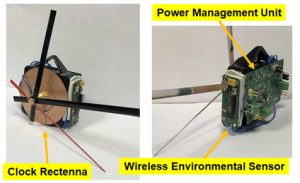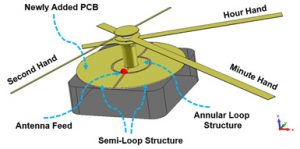[ad_1]
We’re talking wireless energy harvesting, maybe to help power smart sensors and IoT…
The aim of the project, Chaoyun tells us, is to help develop cutting-edge solutions for energy harvesting from ambient signals, whether mobile, TV or WiFi signals. And as a result he has produced a battery-free quartz clock with wireless sensing functions.
RF
Among all the options, he says, RF energy sources are becoming increasingly popular since they are ubiquitously available in most domestic environments regardless of the time, weather and environmental conditions.
“In this project, we have developed the broadband rectifying-antenna (rectenna) technology, which could capture, rectify and convert the RF power of signals over a wide spectrum into DC power. We have significantly overcome the problems on antenna and circuit integration, in particular, a number of novel impedance matching techniques have been developed for such broadband rectennas.”
“More importantly, we have also invented a cutting-edge technique to effectively integrate the antenna to the rectifying and power management circuit without the need of extra matching networks and circuit components, thus reducing the cost, power loss and manufacturing complexity of the product. This technology has been filed to a US patent (US Patent 9,966,656), and bought by a US company.”
The full details of this work have been published on the IEEE, see “Novel Quartz Clock with Integrated Wireless Energy Harvesting and Sensing Functions“, IEEE Transactions on Industrial Electronics (May 2018).
Battery-free quartz clock
“One of our recent achievement on this project is that we have developed the first battery-free quartz clock with wireless sensing functions in the world. The clock hands have been used as antennas to directly sense and capture the wireless energy from ambient signals. Thus the final product of this design only requires the addition of a small piece of simple PCB rectifier circuit on the clock.”
“The clock can be efficiently powered under the coverage of a typical Wi-Fi router. Moreover, the harvested power was used to power a wireless environmental sensor that has been integrated to the clock. The sensor could transmit the data of temperature, humidity, air-pressure, noise level, air-quality and light intensity etc. over a GPRSbee, Bluetooth or LoRaWAN network.”
What this means is that the quartz clock could be self-powered and also be used as a smart indoor weather station or for smart home monitoring…
Excellent, and a really interesting area of work. Thanks for sharing, Chaoyun.
EW BrightSparks 2019
Talking of EW BrightSparks, we are now starting the selection process for the Class of 2019.
We are looking for the young engineers who are already making a difference in the first years of their working life, or who were still studying but are showing the promise to become the people behind big future innovations in electronics. Do you know someone who could be considered?
Enter for EW BrightSparks 2019 »
[ad_2]
Source link


